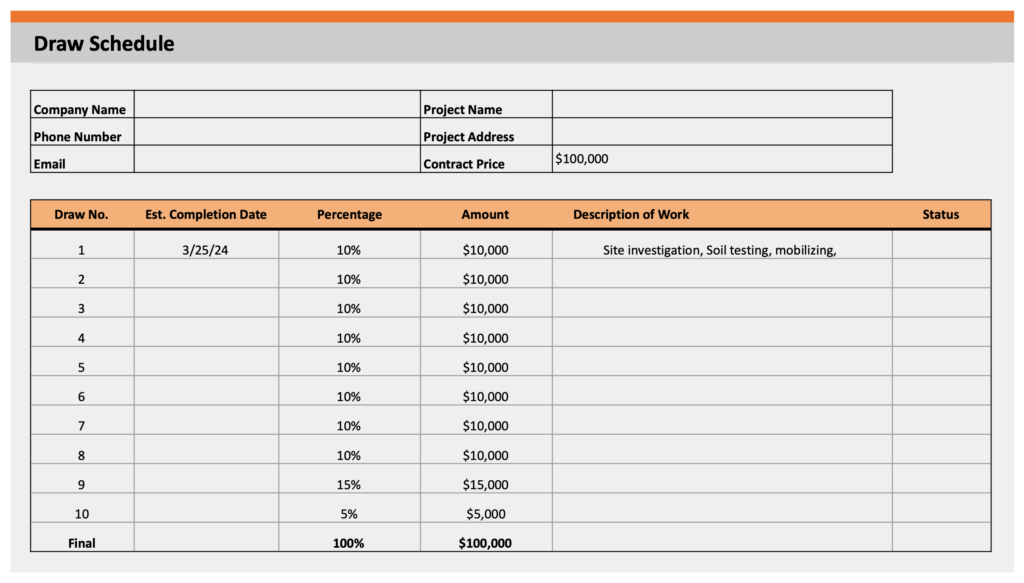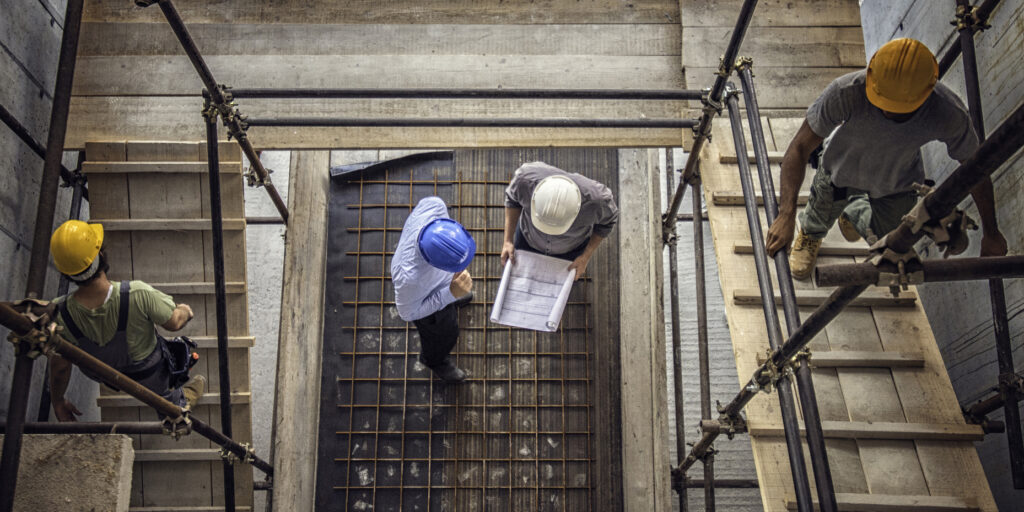— 10 min read
Draw Schedules: Streamlining Construction Finance


Last Updated May 30, 2025

TJ Forbes
Senior Solutions Engineer
19 articles
TJ Forbes is a Senior Solutions Engineer at Procore, specializing in financials products, analytics, ERP integrations, workflows, reporting and accounting solutions. He previously worked as a financial manager and project accountant for Stiles, a commercial real estate firm in Ft. Lauderdale. TJ holds a Masters in Financial Management from Southern Adventist University.

Taylor Riso
Contributing Writer
91 articles
Taylor Riso is a marketing professional with more than 10 years of experience in the construction industry. Skilled in content development and marketing strategies, she leverages her diverse experience to help professionals in the built environment. She currently resides in Portland, Oregon.
Last Updated May 30, 2025

Throughout the lifecycle of a construction project, the ebb and flow of funds are as constant and critical as the work onsite. Significant sums of money are allocated, received, spent, and accounted for at various stages. One factor in understanding the financial health of a project is creating and managing a schedule of the projected inflow of cash, or a construction draw schedule.
In this article, we examine the different components of a construction draw schedule, its importance, the process of creating one — and industry-recommended best practices.
Table of contents
What is a draw schedule?
A construction draw schedule is a financial plan that outlines when project’s funds will be requested over the course of the project, serving as a roadmap for when draw requests are sent, or when payments will be released.
Like most aspects of construction projects, draw schedules can look different depending on the project, but are often planned based on project milestones or the percentage of project completion. Creating and updating a draw schedule is a key component to projecting a job’s cash flow, and understanding the financial health of the project.
Draw schedules are created and used by both owners and contractors. Contractors create a schedule to bill owners, and owners will create a draw schedule to receive cash from the bank.
Often, owners will request a draw schedule in the preconstruction phase so that they can properly plan their own draw schedule with their lender.

Key Stakeholders in the Construction Draw Process
The success of any construction project largely hinges on the effective collaboration among its key stakeholders: contractors, project owners, and lenders. Each plays a pivotal role in the construction draw process, and their coordinated efforts are essential for the smooth execution and completion of the project.
Contractors
For contractors, draw schedules are vital for managing cash flow. They rely on timely payments to procure materials, pay workers, process subcontractor pay applications and keep the project moving forward. Delays in funding can lead to work stoppages and can significantly disrupt the project schedule. Contractors must regularly update project owners and lenders on progress and challenges that impact the draw schedule.
Project Owners
Draw schedules help project owners maintain financial control over the project. By releasing funds in stages, they can ensure that their investment is being used efficiently and that the project is progressing as planned.
For project owners, a draw schedule is not just a tool for monitoring progress but a crucial element in strategic financial planning. It provides them with a clear forecast of when and how much funding will be required at various stages of the project. This foresight is essential for ensuring that the necessary funds are available when needed, thereby avoiding potential cash flow issues.
Project owners must work closely with contractors to understand the project's progress and how that impacts progress payments. They also need to coordinate with lenders to ensure that the financing aligns with the project's needs and timeline.
Creating a Construction Draw Schedule
The creation of a draw schedule heavily relies on knowing what jobs need to be done when, how much that will cost, and how much capital you have to spread over the course of the project. In order to create a draw schedule, you will first need to determine the total contract amount and create a schedule of values.
1. Determine the total contract amount.
Start by establishing the overall financial scope of the project, which is the total amount agreed upon in the contract for the construction work. This will be determined in the prime contract, which will outline the total budget, how and when payments are made, and what is required to attain them.
2. Create a schedule of values.
Without a schedule of values, contractors wouldn’t know when cash is needed, or how much. A schedule of values (SOV) is an itemized list of each activity required to complete the scope of work on a construction project, along with the corresponding costs or values.
Contractors develop the SOV based on the total contract sum and the scope of work specified in the contract. The entire scope is broken down into individual tasks or deliverables and then assigned a corresponding value (i.e. scheduled value).
3. Distribute the project balance over the project schedule.
Allocate the financial scope to align with the project timeline, planned milestones and the specific payment terms outlined in the contract.
One key aspect of distributing the projected balance is making certain that the sum of the projected payments for the upcoming months equals the remaining balance of the contract. This alignment guarantees that the draw requests are synchronized with the project's actual needs and stages, preventing any discrepancies between the planned budget and the actual expenditures.
By meticulously aligning the draw schedule with the project timeline and budget, project managers can effectively oversee the financial flow of a project, supporting its objectives and timeline without any overruns or shortfalls.
4. Establish if retainage is factored into the construction draw schedule.
Another aspect to consider when creating a construction draw schedule is determining whether retainage is included in the schedule calculations. Retainage is a portion of the agreed-upon contract amount, typically around 10%, that is withheld until the project's completion to ensure quality and completion of work. Understanding and clearly communicating about the inclusion or exclusion of retainage in draw schedule calculations is crucial for avoiding financial miscalculations.
Updating the Draw Schedule
Once a draw schedule is created, it will still require maintenance, reviews, and updates. Keeping an up-to-date draw schedule will not only maintain a project’s financial health but can facilitate transparency and understanding among all project stakeholders.
Regularly review and update the construction draw schedules.
The ongoing process throughout a project’s lifecycle of regularly reviewing and updating the construction draw schedule involves assessing it at set intervals or after significant project milestones to ensure it remains aligned with the current status and needs of the project. These reviews allow for the timely identification and incorporation of any necessary changes, whether due to unforeseen challenges, project scope adjustments, change orders or shifts in timelines.
Reviewing the draw schedule not only maintains the schedule's relevance and accuracy, but also fosters a proactive stance in managing the project's financial aspects, ensuring that the draw schedule continues to effectively reflect and support the project's evolving demands.
Verify the work put in place.
Verifying the accuracy of work in place is an essential aspect of managing construction draw schedules effectively for both owners and general contractors. This process is crucial in ensuring that payments to contractors and subcontractors are precisely aligned with the work they have completed.
For example, as a general contractor, it's critical to avoid overpayment for incomplete work, as this can lead to significant financial imbalances. An oversight in verification might result in paying for work that hasn't been done, while the project owner may not compensate for these discrepancies. This scenario can quickly lead to a liquidity problem, where the GC is left covering costs that cannot be recouped until later.
If a task is marked as completed without proper verification and the owner does not approve the corresponding payment, the financial impact can be significant. This can lead to borrowing additional funds to cover these costs, incurring extra expenses due to the cost of capital — especially if it goes beyond the line of credit. Therefore, thorough validation of the work completed is vital to maintain financial stability and ensure the efficient execution of the draw schedule.
Stay updated on what’s happening in construction.
Subscribe to Blueprint, Procore’s free construction newsletter, to get content from industry experts delivered straight to your inbox.

The Benefits of Draw Scheduling
Construction draw schedule acts as a mechanism to align financials for all project stakeholders. A draw schedule can transform the management and execution of construction projects, especially in scenarios that demand meticulous financial and operational coordination.
Enhanced Financial Management
A draw schedule provides a meticulous framework for monitoring and controlling the project's budget. It allows project managers and stakeholders to track spending closely, ensuring that funds are allocated efficiently and effectively. This level of oversight is crucial in preventing budget overruns and maintaining a healthy cash flow throughout the construction process, thereby safeguarding the financial health of the project.
Increased Accountability
By tying payments to specific project milestones, a draw schedule ensures that work is completed to a satisfactory standard before further funds are released. For project owners, this milestone-based approach promotes a higher level of accountability among contractors and subcontractors, as their payment is directly linked to their progress and performance. It also enhances transparency with all stakeholders, providing a clear, shared understanding of financial disbursements and project status.
Timely Project Completion
The structure of a draw schedule inherently incentivizes contractors to adhere to timelines. Since the release of funds is contingent upon the completion of specific stages, there's a direct financial motivation to meet or exceed project milestones on schedule. This approach significantly reduces the likelihood of delays, facilitating a smoother and more predictable project trajectory, which is essential for meeting deadlines and satisfying stakeholders.
Risk Mitigation
A draw schedule minimizes financial risks by distributing funds in stages rather than a large sum. This staggered funding approach reduces the chances of financial mismanagement and ensures that the project can adapt to unforeseen changes or delays. Such flexibility in financial planning is key to maintaining the project's momentum and navigating the uncertainties common in construction projects.
Improved Relationships across Project Teams
Regular, milestone-based payments create a foundation for strong, positive relationships between the project owners and general contractors and general contractors and speciality contractors. General contractors and subcontractors are assured of timely payments upon completion of agreed-upon phases, which aids in their resource planning and maintains their motivation and commitment to the project. This system of prompt payments fosters trust and reliability, which are vital for the continued smooth operation and success of any construction project.
Utilizing Software for Efficient Draw Schedule Management
Incorporating construction project management software into the draw scheduling process is extremely advantageous when managing construction projects. This streamlines and automates various aspects of draw scheduling, enhancing efficiency and accuracy. By leveraging such software, all project parties can easily track project progress, automate the calculation of draw amounts, and maintain real-time updates on the budget and timeline. This not only reduces the likelihood of human error but also saves considerable time that would otherwise be spent on manual calculations and updates.
The use of project management software ensures that the construction draw schedule is managed with a high degree of precision and responsiveness, adapting quickly to changes in the project's scope or timeline, and providing a comprehensive, accessible view of the project's financial status for all stakeholders.
Courses about construction.
For construction.
Unlock your career potential with our free educational courses on Health & Safety, Data in Construction, and more.
The Draw Schedule: An Indispensable Financial Management Tool
Construction draw schedules serve as an indispensable tool in the effective management and successful execution of construction projects. They bring a structured approach to financial planning, ensuring that funds are allocated and disbursed in alignment with project progress. By implementing best practices such as regular updates, precise verification of work, and clear communication about retainage, stakeholders can maintain a balanced and transparent financial environment. This fosters accountability and efficiency, minimizes financial risks and enhances the likelihood of timely project completion.
As the construction industry continues to evolve and become increasingly digitized, the role of construction draw schedules in achieving project objectives remains crucial. This shift highlights the need for continued meticulous planning, collaboration, and adaptable financial management — all of which are now being enhanced by technological advancements in the industry.
Was this article helpful?
Thank you for your submission.
100%
0%
You voted that this article was . Was this a mistake? If so, change your vote
Scroll less, learn more about construction.
Subscribe to The Blueprint, Procore’s construction newsletter, to get content from industry experts delivered straight to your inbox.
By clicking this button, you agree to our Privacy Notice and Terms of Service.
Thank you!
You’re signed up to receive The Blueprint newsletter from Procore. You can unsubscribe at any time.
Categories:
Written by

TJ Forbes
Senior Solutions Engineer | Procore Technologies
19 articles
TJ Forbes is a Senior Solutions Engineer at Procore, specializing in financials products, analytics, ERP integrations, workflows, reporting and accounting solutions. He previously worked as a financial manager and project accountant for Stiles, a commercial real estate firm in Ft. Lauderdale. TJ holds a Masters in Financial Management from Southern Adventist University.
View profile
Taylor Riso
Contributing Writer
91 articles
Taylor Riso is a marketing professional with more than 10 years of experience in the construction industry. Skilled in content development and marketing strategies, she leverages her diverse experience to help professionals in the built environment. She currently resides in Portland, Oregon.
View profileExplore more helpful resources

Construction Accounting Software: Key Features and What To Look For
Commercial contractors manage large and complicated budgets that can have slow payment rates and volatile costs. They also have to accurately allocate job costs based on specific factors such as...

Construction Collaboration: Navigating the Intersection of Project Management and Accounting
Accounting and project teams work together to move the financial aspects of projects through to completion. Data sharing allows for concurrent review to make this possible. Teams need to share...

What are Committed Costs in Construction Accounting?
In construction projects, managing finances can be a challenging task — but understanding committed costs can simplify the process. Committed costs refer to expenses that are guaranteed through formal agreements,...

Understanding Construction Financial Statements
For construction firms, effectively managing financial statements is an important building block for success. These documents play a key role in tracking performance, maintaining financial health and securing future projects....
Free Tools
Calculators
Use our calculators to estimate the cost of construction materials for your next project.
Templates
Find a template to help you with your construction project tasks.
Material Price Tracker
Get the latest U.S. retail prices and view historical trends for common building materials.
Glossary
Explore key terms and phrases used in the industry.
